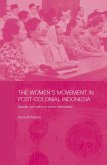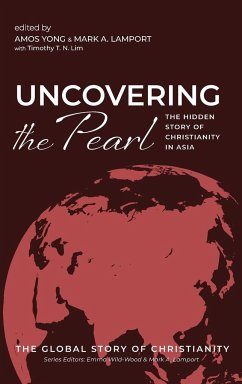Civilizing Missions in Colonial and Postcolonial South Asia
From Improvement to Development
Herausgeber: Watt, Carey A.; Mann, Michael
Civilizing Missions in Colonial and Postcolonial South Asia
From Improvement to Development
Herausgeber: Watt, Carey A.; Mann, Michael
- Gebundenes Buch
- Merkliste
- Auf die Merkliste
- Bewerten Bewerten
- Teilen
- Produkt teilen
- Produkterinnerung
- Produkterinnerung
This collection provides a historical exploration of the tensions and complexities of civilizing missions undertaken by British or Indian states or organizations in nineteenth- and twentieth-century South Asia.
Andere Kunden interessierten sich auch für
![Colonialism as Civilizing Mission Colonialism as Civilizing Mission]() Colonialism as Civilizing Mission90,99 €
Colonialism as Civilizing Mission90,99 €![Colonialism as Civilizing Mission Colonialism as Civilizing Mission]() Colonialism as Civilizing Mission38,99 €
Colonialism as Civilizing Mission38,99 €![The Women's Movement in Postcolonial Indonesia The Women's Movement in Postcolonial Indonesia]() Elizabeth MartynThe Women's Movement in Postcolonial Indonesia169,99 €
Elizabeth MartynThe Women's Movement in Postcolonial Indonesia169,99 €![Uncovering the Pearl Uncovering the Pearl]() Uncovering the Pearl32,99 €
Uncovering the Pearl32,99 €![Uncovering the Pearl Uncovering the Pearl]() Uncovering the Pearl46,99 €
Uncovering the Pearl46,99 €![The Women's Movement in Postcolonial Indonesia The Women's Movement in Postcolonial Indonesia]() Elizabeth MartynThe Women's Movement in Postcolonial Indonesia60,99 €
Elizabeth MartynThe Women's Movement in Postcolonial Indonesia60,99 €![An Environmental History of Postcolonial North India An Environmental History of Postcolonial North India]() Eric A. StrahornAn Environmental History of Postcolonial North India91,55 €
Eric A. StrahornAn Environmental History of Postcolonial North India91,55 €-
-
-
This collection provides a historical exploration of the tensions and complexities of civilizing missions undertaken by British or Indian states or organizations in nineteenth- and twentieth-century South Asia.
Produktdetails
- Produktdetails
- Verlag: Anthem Press
- Seitenzahl: 344
- Erscheinungstermin: 15. März 2011
- Englisch
- Abmessung: 235mm x 157mm x 25mm
- Gewicht: 710g
- ISBN-13: 9781843318644
- ISBN-10: 1843318644
- Artikelnr.: 28898427
- Herstellerkennzeichnung
- Libri GmbH
- Europaallee 1
- 36244 Bad Hersfeld
- gpsr@libri.de
- Verlag: Anthem Press
- Seitenzahl: 344
- Erscheinungstermin: 15. März 2011
- Englisch
- Abmessung: 235mm x 157mm x 25mm
- Gewicht: 710g
- ISBN-13: 9781843318644
- ISBN-10: 1843318644
- Artikelnr.: 28898427
- Herstellerkennzeichnung
- Libri GmbH
- Europaallee 1
- 36244 Bad Hersfeld
- gpsr@libri.de
Edited by Carey A. Watt and Michael Mann
Introduction: The Relevance and Complexity of Civilizing Missions c.
1800-2010; Part One. The Raj’s Reforms and Improvements: Aspects of the
British Civilizing Mission; 1. Conjecturing Rudeness: James Mill’s
Utilitarian Philosophy of History and the British Civilizing Mission; 2.
Art, Artefacts and Architecture: Lord Curzon, the Delhi Arts Exhibition of
1902-03 and the Improvement of India’s Aesthetics; Part Two. Colonialism,
Indians and Nongovernmental Associations: The Ambiguity and Complexity of
‘Improvement’; 3. Incorporation and Differentiation: Popular Education and
the Imperial Civilizing Mission in Early Nineteenth Century India; 4.
Reclaiming Savages in ‘Darkest England’ and ‘Darkest India’: The Salvation
Army as Transnational Agent of the Civilizing Mission; 5. Mediating
Modernity: Colonial State, Indian Nationalism and the Renegotiation of the
‘Civilizing Mission’ in the Indian Child Marriage Debate of 1927-1932; Part
Three. Indian ‘Self-Civilizing’ Efforts c. 1900-1930; 6. ‘Civilizing
Sisters’: Writings on How to Save Women, Men, Society and the Nation in
Late Colonial India; 7. From ‘Social Reform’ to ‘Social Service’: Indian
Civic Activism and the Civilizing Mission in Colonial Bombay c. 1900-20;
Part Four. Transcending 1947: Colonial and Postcolonial Continuities; 8.
Female Infanticide and the Civilizing Mission in Postcolonial India: A Case
Study from Tamil Nadu c. 1980-2006; 9. Philanthropy and Civilizing Missions
in India c. 1820-1960: States, NGOs and Development; Afterword:
Improvement, Progress and Development; List of Contributors; Index
1800-2010; Part One. The Raj’s Reforms and Improvements: Aspects of the
British Civilizing Mission; 1. Conjecturing Rudeness: James Mill’s
Utilitarian Philosophy of History and the British Civilizing Mission; 2.
Art, Artefacts and Architecture: Lord Curzon, the Delhi Arts Exhibition of
1902-03 and the Improvement of India’s Aesthetics; Part Two. Colonialism,
Indians and Nongovernmental Associations: The Ambiguity and Complexity of
‘Improvement’; 3. Incorporation and Differentiation: Popular Education and
the Imperial Civilizing Mission in Early Nineteenth Century India; 4.
Reclaiming Savages in ‘Darkest England’ and ‘Darkest India’: The Salvation
Army as Transnational Agent of the Civilizing Mission; 5. Mediating
Modernity: Colonial State, Indian Nationalism and the Renegotiation of the
‘Civilizing Mission’ in the Indian Child Marriage Debate of 1927-1932; Part
Three. Indian ‘Self-Civilizing’ Efforts c. 1900-1930; 6. ‘Civilizing
Sisters’: Writings on How to Save Women, Men, Society and the Nation in
Late Colonial India; 7. From ‘Social Reform’ to ‘Social Service’: Indian
Civic Activism and the Civilizing Mission in Colonial Bombay c. 1900-20;
Part Four. Transcending 1947: Colonial and Postcolonial Continuities; 8.
Female Infanticide and the Civilizing Mission in Postcolonial India: A Case
Study from Tamil Nadu c. 1980-2006; 9. Philanthropy and Civilizing Missions
in India c. 1820-1960: States, NGOs and Development; Afterword:
Improvement, Progress and Development; List of Contributors; Index
Introduction: The Relevance and Complexity of Civilizing Missions c.
1800-2010; Part One. The Raj’s Reforms and Improvements: Aspects of the
British Civilizing Mission; 1. Conjecturing Rudeness: James Mill’s
Utilitarian Philosophy of History and the British Civilizing Mission; 2.
Art, Artefacts and Architecture: Lord Curzon, the Delhi Arts Exhibition of
1902-03 and the Improvement of India’s Aesthetics; Part Two. Colonialism,
Indians and Nongovernmental Associations: The Ambiguity and Complexity of
‘Improvement’; 3. Incorporation and Differentiation: Popular Education and
the Imperial Civilizing Mission in Early Nineteenth Century India; 4.
Reclaiming Savages in ‘Darkest England’ and ‘Darkest India’: The Salvation
Army as Transnational Agent of the Civilizing Mission; 5. Mediating
Modernity: Colonial State, Indian Nationalism and the Renegotiation of the
‘Civilizing Mission’ in the Indian Child Marriage Debate of 1927-1932; Part
Three. Indian ‘Self-Civilizing’ Efforts c. 1900-1930; 6. ‘Civilizing
Sisters’: Writings on How to Save Women, Men, Society and the Nation in
Late Colonial India; 7. From ‘Social Reform’ to ‘Social Service’: Indian
Civic Activism and the Civilizing Mission in Colonial Bombay c. 1900-20;
Part Four. Transcending 1947: Colonial and Postcolonial Continuities; 8.
Female Infanticide and the Civilizing Mission in Postcolonial India: A Case
Study from Tamil Nadu c. 1980-2006; 9. Philanthropy and Civilizing Missions
in India c. 1820-1960: States, NGOs and Development; Afterword:
Improvement, Progress and Development; List of Contributors; Index
1800-2010; Part One. The Raj’s Reforms and Improvements: Aspects of the
British Civilizing Mission; 1. Conjecturing Rudeness: James Mill’s
Utilitarian Philosophy of History and the British Civilizing Mission; 2.
Art, Artefacts and Architecture: Lord Curzon, the Delhi Arts Exhibition of
1902-03 and the Improvement of India’s Aesthetics; Part Two. Colonialism,
Indians and Nongovernmental Associations: The Ambiguity and Complexity of
‘Improvement’; 3. Incorporation and Differentiation: Popular Education and
the Imperial Civilizing Mission in Early Nineteenth Century India; 4.
Reclaiming Savages in ‘Darkest England’ and ‘Darkest India’: The Salvation
Army as Transnational Agent of the Civilizing Mission; 5. Mediating
Modernity: Colonial State, Indian Nationalism and the Renegotiation of the
‘Civilizing Mission’ in the Indian Child Marriage Debate of 1927-1932; Part
Three. Indian ‘Self-Civilizing’ Efforts c. 1900-1930; 6. ‘Civilizing
Sisters’: Writings on How to Save Women, Men, Society and the Nation in
Late Colonial India; 7. From ‘Social Reform’ to ‘Social Service’: Indian
Civic Activism and the Civilizing Mission in Colonial Bombay c. 1900-20;
Part Four. Transcending 1947: Colonial and Postcolonial Continuities; 8.
Female Infanticide and the Civilizing Mission in Postcolonial India: A Case
Study from Tamil Nadu c. 1980-2006; 9. Philanthropy and Civilizing Missions
in India c. 1820-1960: States, NGOs and Development; Afterword:
Improvement, Progress and Development; List of Contributors; Index









